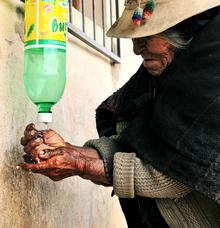PLoS One. 2012;7(2):e31316 Feb 8.
Integrated HIV testing, malaria, and diarrhea prevention campaign in Kenya: modeled health impact and cost-effectiveness.
Kahn JG, Muraguri N, Harris B, Lugada E, Clasen T, Grabowsky M, Mermin J, Shariff S.
Philip R Lee Institute for Health Policy Studies, University of California, San Francisco, California, United States of America. jgkahn@ucsf.edu
BACKGROUND: Efficiently delivered interventions to reduce HIV, malaria, and diarrhea are essential to accelerating global health efforts. A 2008 community integrated prevention campaign in Western Province, Kenya, reached 47,000 individuals over 7 days, providing HIV testing and counseling, water filters, insecticide-treated bed nets, condoms, and for HIV-infected individuals cotrimoxazole prophylaxis and referral for ongoing care. We modeled the potential cost-effectiveness of a scaled-up integrated prevention campaign.
METHODS: We estimated averted deaths and disability-adjusted life years (DALYs) based on published data on baseline mortality and morbidity and on the protective effect of interventions, including antiretroviral therapy. We incorporate a previously estimated scaled-up campaign cost. We used published costs of medical care to estimate savings from averted illness (for all three diseases) and the added costs of initiating treatment earlier in the course of HIV disease.
RESULTS: Per 1000 participants, projected reductions in cases of diarrhea, malaria, and HIV infection avert an estimated 16.3 deaths, 359 DALYs and $85,113 in medical care costs. Earlier care for HIV-infected persons adds an estimated 82 DALYs averted (to a total of 442), at a cost of $37,097 (reducing total averted costs to $48,015). Accounting for the estimated campaign cost of $32,000, the campaign saves an estimated $16,015 per 1000 participants. In multivariate sensitivity analyses, 83% of simulations result in net savings, and 93% in a cost per DALY averted of less than $20.
DISCUSSION: A mass, rapidly implemented campaign for HIV testing, safe water, and malaria control appears economically attractive.




